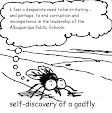By any reasonable measure, public education is performing poorly. Fifty percent literacy in math and reading, and 67% graduation rates point to fundamental flaws in the way we're doing business.
Teachers play a part in the failure, but overall, a smaller part than most people think. There is no weak link in public education, the whole chain is failing from one end to the other.
There are a few inescapable facts and obstacles to educating young children in particular. Their attention span and interests for one; they really are kitten like in their approach to learning.
In stark contrast to individual student needs, we find a need in public education to immediately seat these kids in five rows of six desks, there to join into a "thought choir" thinking and learning in unison, and then singing together in standardized testing recitals.
You can't make people learn. You especially cannot make the immature learners learn. Learning is the responsibility of the learner. If the learner is disengaged, for any reason, for any amount of time, there is no learning. You cannot make people pay attention; you cannot make children pay attention to what you want them to pay attention to.
Children pay attention all the time. Every minute of every day, they are paying attention to some thing, but rarely the same thing.
Succeeding in public education's cemetery seating model of education, depends upon the ability to get thirty kittens to pay attention to the same thing, at the same time, all day long, for twelve years. This though it could be argued that the only time they really need to be on the same page on the same day, is the day when their cumulative achievement is finally measured by "testing" and they are given a diploma that implies certain levels of achievement in basic areas.
An important mission of public education is to create independent lifelong learners. That objective should be its top priority, and its most immediate objective. Yet teachers are being evaluated on their ability to make many kids learn in unison; using a fundamentally flawed, manifestly obsolete education model.
What do we want from teachers? What do we need?
Most kids don't need a "teacher" most of the time.
Most of the time, most kids just need to be watched.
When a student does need a teacher, they need a whole teacher, a teacher who can give them individual attention for as long as they need it.
Cemetery seating dictates that every kid will have (a small part of) a teacher all of the time; one thirtieth of a teacher, all the time.
Students need "teachers" when they need help learning; students with learning disabilities for example. Students struggling with subject material, need subject material experts. Students who need help finding information don't need a "teacher". Students who need help staying on task, don't need a "teacher".
Regardless of the model used, there is an elephant in the room with respect to evaluating teachers. No one wants to talk about subordinate evaluation, having students evaluate teachers.
It isn't surprising, because we don't talk about teachers evaluating administrators either.
Sunday, July 22, 2012
Ed reform and teacher evaluation
Posted by
ched macquigg
at
6:37 AM
![]()
Subscribe to:
Post Comments (Atom)

1 comment:
Long years ago (1940) my High School, Chapman Technical High School located in New London, Connecticut recognized all students did not march to the same drummer! Accordingly, students were grouped in keeping with their readily identifiable academic abilities, into 8 catagories: A - H with group A being the brightest and H being the most difficult. Compared with the best thinking of the time this was a highly successful(learning environment)endeavor making for happier kids and teachers. The gradutation rate was high. Although primative I believe this is a better way to go than the status quo. But! We can't do that can we? It would be discrimination wouldn't it?
Post a Comment